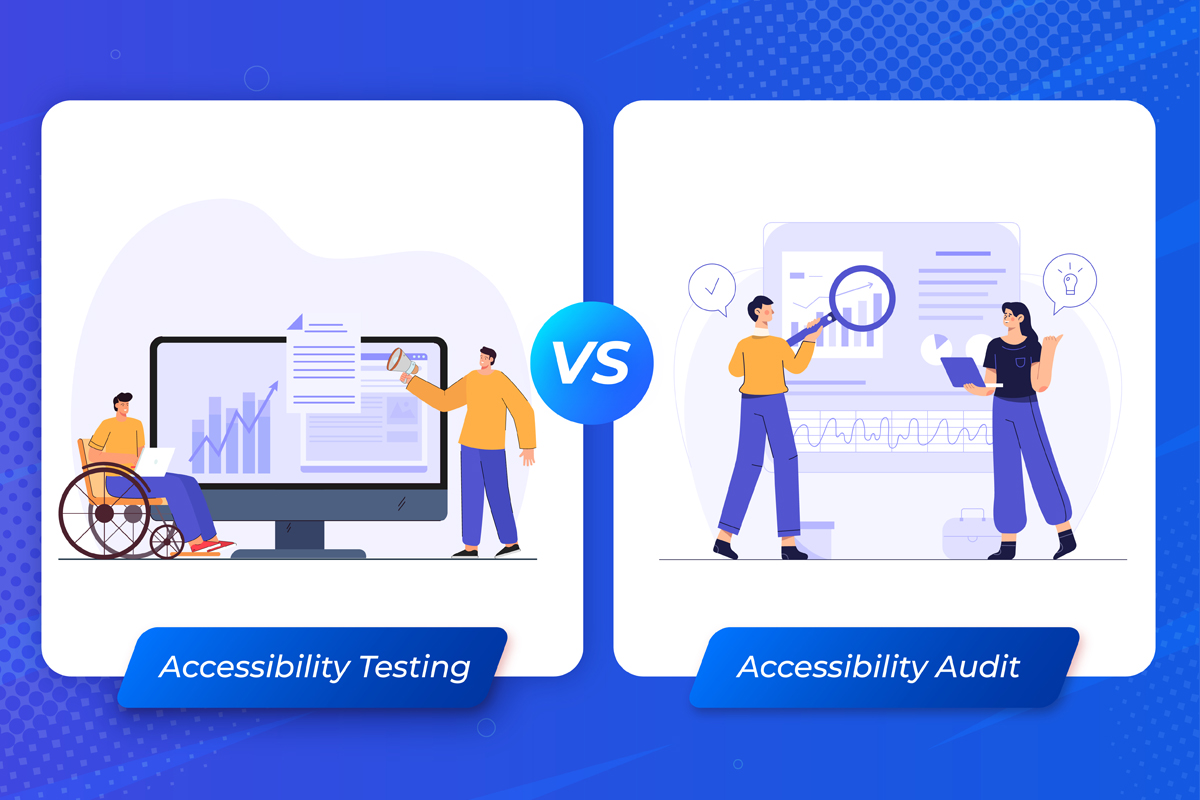Accessibility Testing vs Audit: What's the Difference
 Aditya Bikkani
Aditya Bikkani
If you want to make your website or app accessible to everyone, you need to evaluate how well it meets the Web Content Accessibility Guidelines (WCAG), the international standard for web accessibility. The most essential idea is to evaluate digital content using various methods and tools, considering the benefits and limitations of each approach.
In this blog, we will explain the difference between accessibility testing and accessibility auditing. We will also discuss why you might need both methods to ensure your website or app is fully accessible and compliant with WCAG.
What is accessibility testing?
Accessibility testing is the process of evaluating whether your website or app can be used by people with different types of disabilities, such as visual, hearing, motor, or cognitive impairments. It can be done manually or automatically, using various tools and techniques.
Manual accessibility testing involves using a keyboard, a screen reader, a magnifier, a color contrast checker, or other assistive technologies to simulate how users with disabilities interact with your website or app. It can help you identify issues that affect the usability and functionality of your website or app for different user groups.
Automatic accessibility testing involves using software or online services that scan your website or app for potential accessibility violations based on WCAG criteria. It can help you detect issues that affect the code quality and structure of your website or app, such as missing alt-text, improper headings, or insufficient color contrast.
What is an accessibility audit?
An accessibility audit is a comprehensive and systematic evaluation of your website's or app's accessibility level and compliance with WCAG standards. The audit is usually performed by an independent team of experts who have extensive knowledge and experience in web accessibility.
Accessibility audits involve a combination of manual and automatic accessibility testing, as well as other methods such as user testing, expert review, and heuristic analysis. The audit aims to provide you with an accurate and detailed report of your website's or app's accessibility status, including:
Lists all the accessibility issues found on your website or app, categorized by WCAG level (A, AA, or AAA) and severity (critical, high, medium, or low).
Descriptions of each issue, its impact on users with disabilities, and its location on your website or app
Recommendations for fixing each issue, along with examples and best practices
A summary of your website's or app's strengths and weaknesses in terms of accessibility
A score or rating of your website's or app's overall accessibility level and compliance with WCAG standards.
What are the pros and cons of each method?
Both accessibility testing and accessibility auditing have their benefits and limitations when it comes to evaluating web accessibility. Here are some of the main advantages and disadvantages of each method:
Benefits of Automated Accessibility Testing
Can be done quickly and easily using various tools and techniques.
Helps you identify the low-hanging fruit of accessibility issues on your website or app.
Provides you with a general idea of how users with disabilities experience your website or app.
Limitations
Cannot cover all the aspects and scenarios of web accessibility.
Does not detect specific accessibility issues on your website or app.
The report is not comprehensive.
Benefits of a Manual Accessibility Audit
Provides you with a comprehensive and accurate assessment of your website's or app's accessibility level and compliance with WCAG standards.
Helps you identify all the types and levels of accessibility issues on your website or app, including complex or hidden errors, with the help of assistive technology and manual code review.
Provides you with actionable and specific recommendations for fixing each issue.
Limitations
It is time-consuming and costly to conduct.
Requires a high level of expertise and experience in web accessibility.
Why would you require both methods?
As you can see, both automated accessibility testing and manual accessibility auditing have their strengths and weaknesses when evaluating web accessibility. However, rather than choosing one method over the other, you might need both methods to ensure your website or app is fully accessible and compliant with WCAG standards. Or even a hybrid approach that combines the two testing methodologies
Automated Accessibility testing can help check some aspects of web accessibility during the development process. It can help you catch some errors early on and avoid costly and time-consuming fixes. It can also help you gain some insight into how Assistive Technology interacts with your website or app.
A manual accessibility audit can help you verify and validate your website's or app's accessibility level and compliance with WCAG standards. It can help you identify and fix all the accessibility issues on your website or app, including complex errors that are usually missed by software. The audit can also help you improve your website's or app's usability and quality for all users.
By combining both methods, you can ensure that your website or app meets the web accessibility requirements and expectations of your users, customers, and stakeholders. Furthermore, you can also demonstrate your commitment to digital inclusion and social responsibility.
How can we help you?
At AEL Data, we offer both automated accessibility testing and manual accessibility audit services as a hybrid approach for your website or app. We have a team of certified and experienced web accessibility experts who can help you evaluate and improve your website's or app's accessibility level and compliance with WCAG standards.
We use a variety of tools and techniques to conduct manual and automatic accessibility testing on your website or app. We also provide a detailed and comprehensive report of our findings and recommendations, along with a score or rating of your website's or app's accessibility level.
Feel free to contact AEL Data if you would like assistance with your accessibility issues or a review of the accessibility of your website.
Subscribe to my newsletter
Read articles from Aditya Bikkani directly inside your inbox. Subscribe to the newsletter, and don't miss out.
Written by

Aditya Bikkani
Aditya Bikkani
Aditya is the COO of AELData, a growing technology company in the Digital Publishing and Education sectors. He is also an entrepreneur and founder of an accessibility tool called LERA. A W3C COGA (Cognitive and Learning Disabilities Accessibility) Community Member Aditya contributes to researching methodologies to improve web accessibility and usability for people with cognitive and learning disabilities. Aditya’s passion lies with Accessibility and Education, trying to remove barriers to learning.